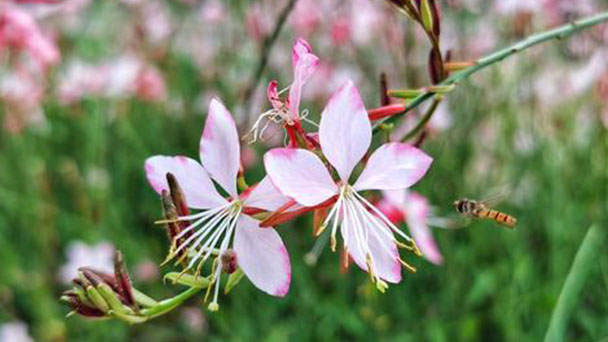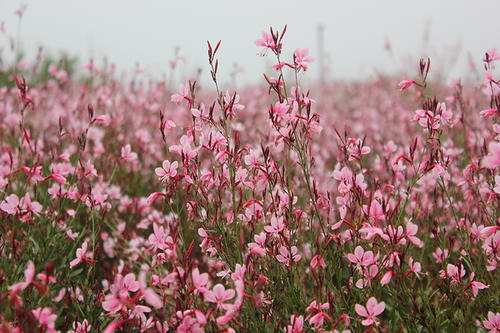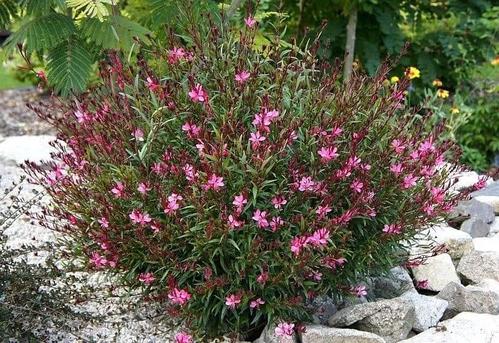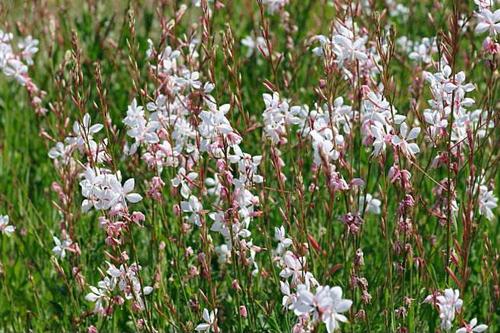Gaura (Gaura lindheimeri) profile
Written by Maggie
Oct 19 2021

Gaura (Gaura Lindheimeri Engelm. Et Gray) is a perennial herb of the genus Gaura in the Willow Leaf family. Leaves are alternate, leaves ovate-lanceolate, base gradually narrow into a short stalk, the edge of a serrate or undulate. Flowers are purplish red, into dense spikes, long inflorescences. Gaura is native to the United States.
Gaura picture

Gaura info
| Botanical Name | Gaura lindheimeri |
| Common Names | Wandflower, whirling butterfly, bee blossom |
| Plant Type | Herbaceous perennial |
| Sun | Full |
| Hardiness Zones | 5, 6, 7, 8, 9 (USDA) |
| Flower color | White, pink, white-pink |
| Native Area | North America |
| Mature size | 15–48 in. tall, 15–48 in. wide |
Morphological features of Gaura
Stem branches
Gaura is a perennial stout herb, often clumped; Stems are erect, 60-100 cm tall, often much branched, reddish in autumn, pilose to villous.
Leaf
Leaves of Gaura sessile are elliptically lanceolate or oblanceolate, 3 -- 9 cm long and 5 -- 11 mm wide, tapered upward, apex acute, base cuneate, margin with distant odontoid or undulate teeth, both surfaces subadnate with villous hairs.
Flowers
Inflorescences of Gaura long spikes, stem branches apical, unbranched or few branched, erect, 20 -- 50 cm long; Bracts are narrowly elliptic, lanceolate, or linear, 0.8 -- 3 cm long, 2 -- 5 mm wide. The flowers bloom near dawn; Flower tubes are 4 -- 9 mm long, inner surface half hairy; Sepals are 10 -- 15 mm long, 1 -- 2 mm wide, dilated villous, flowers reflexed when open; Petals are white, later pink, laterally arranged, obovate or elliptic, 12 -- 15 mm long, 5 -- 8 mm wide; Filaments of Gaura are 8 -- 12 mm long; Anthers are reddish, 3.5 -- 4 mm long; Style is 20-23 mm long, hairy near base; Stigma deep 4-lobed, protruding above anthers.
Fruit
Capsule of Gaura is nutlike, narrowly fusiform, 6 -- 9 mm long, 2 -- 3 mm in diameter, brown when ripe, with distinct angles. Gaura has 1-4 seeds, sometimes only partially ovule developed, ovate, 2 -- 3 mm long, 1 -- 1.5 mm in diameter, pale brown.
The ecological habits of Gaura
Gaura is a perennial herb. Gaura is cold resistant, like cool and semi-humid climate, sunshine, fertile, loose and well drained sandy soil.Suitable for growing in sunny places, tolerant to half shade. The soil should be fertile, moist, well drained and drought tolerant.
Gaura likes cool, wet and sunny environments, relatively cold resistance. Gaura is resistant to -35℃ low temperature.
Light: Suitable for growing in sunny places, resistant to half shade.
Soil (medium) : the soil quality requirements are not strict, with loose, fertile, well drained sandy loam is better.
How to grow and care for Gaura
Water
Gaura likes a slightly wet environment, and watering should follow the principle of "dry not watering, watering thoroughly". Summer about 2 days of watering once, spring and autumn about 3 days of watering once, winter to reduce watering. Note: a few days of watering is only about the time, but also according to the basin soil, environmental humidity judgment.
Fertilizer
Gaura generally follows the principle of "thin fertilizer and frequent fertilizer", applying fertilizer every ten days and half a month during the growing season.
Soil
Gaura does not have high requirements for soil, and prefers loose, fertile, breathable, humus-rich and well-drained sandy soil. Gaura soil recipe: garden soil, sandy loam, leaf rot with some perlite for ventilation in a 3:2:4:1 ratio.
Repotting
Gaura is usually a biannual replacement for the larger pot and an annual replacement for the smaller pot, in the spring. Remove some old roots and over-long roots, remove the old soil and replace it with new culture soil to help Gaura bloom.
Environment
Gaura likes to grow in full sun and can tolerate semi-shade.
Temperature
The suitable temperature for Gaura growth is generally between 15℃ and 25℃.

Gaura propagation
Sowing or branching method of propagation, spring sowing, autumn sowing can be appropriate, germination temperature 15-20℃, strong growth.Suitable for group planting, also can be used as flower arrangement.
Autumn sowing, seedlings need low temperature vernalization, sunshine, soil, water and fertilizer according to the growth habits catalog. Germinating temperature: 8℃ to 20℃, germinating days 12 to 20 days, growth temperature: 15℃ to 25℃, growth days generally sowing in autumn, the next spring and summer flowering.
The species classification of Gaura
G biennis
Herbs annual or biennial, taproot cylindrical; Stem erect, branched, densely pubescent, the upper part also mixed glandular hairs. Basal leaves oblanceolate, apex acute, base tapering, margin linear undulate, midvein white, abaxial surface ridged, veins and margins pubescent, intervein sparsely hairy; Cauline leaves sessile, elliptic, tapering upward, apex and base tapering, entire or shallowly undulate dentate on each side, trichome homobasal leaves.
Inflorescences racemose, stems apical, with a few branches, erect, anthesis constantly elongate, densely pubescent and glandular hairs; Bracts ovate to lanceolate. Flowers bloom in the evening; Sepals green, proximally reddish, linear, reflexed, abaxially sparsely puberulent; Petals row laterally, white to pink, oblong, apex obtuse, base with short claws;Stamens 8, filaments white;Anthers yellow, linear; Pollen is about 50% developed; Style glabrous; Stigma green, 4-lobed. Capsule short fusiform, with distinct angles.Seeds usually 1 mature, oblong-ovate, pale brown.
G parviflora
Herbs annual, taproots up to 2 cm in diameter, whole plant especially upper stem, inflorescence, leaves, bracts, sepals honeyed with extended grayish white long hairs and glandular hairs; Stem erect, unbranched, or few branches below apical inflorescence, 50 -- 100 cm tall. Basal leaves broadly oblateolate, apex acute, base tapering downward to stalker. Cauline leaves narrowly elliptic, oblong-ovate, sometimes rhombic-ovate, apex acuminate or acute, base cuneate subextension to stalk.Inflorescence spicate, sometimes with a few branches, stem apex, often pendulous; Bracts linear. The flowers bloom in the evening; Flower tube reddish;Sepals green, linear-lanceolate, anthesis reflexed; Petals white, later reddish, obovate, apex obtuse, base clawed; Filaments with scalelike appendages at base, anthers yellow, oblong, pollen directly pollinated on stigma at or before anthesis (self-fertilization); Style part protruding flower tube; Stigma surrounded by anthers, with deep 4-lobed.Capsule nutlike, fusiform, with inconspicuous 4 - rowed. Seeds 4, or 3 (with 1-locule undeveloped ovules), ovate, reddish brown.
The distribution of Gaura
Gaura is native to the southern Louisiana and Texas of the United States, mainly distributed in the temperate North America, China's Beijing, Shandong, Nanjing, Zhejiang, Jiangxi, Hong Kong and other introduced species, and escaped into the wild.
The garden use of Gaura
Gaura is very ornamental, suitable for group planting, for flower beds, flower borders, ground, potted plants, lawn decoration, suitable for garden green space, many group plants, can also be used for garden greening. Gaura can also be used as flower arrangement.

Latest Updated
- Benefits of Bugleweed - 7 Science-backed Health Benefits
- Bugleweed Dangers & Side Effects - Is It Poisonous?
- How to Plant Evergreen Trees - What You Should Know
- When to Plant Evergreens - Grow Guide for Evergreen Trees
- 12 Wonderful Evergreen Shrubs for Your Garden
- 12 Popular Evergreen Plants with Pictures for Beginners
- When And How To Prune A Lilac Bush Like a Pro
- How to Grow & Care for Lilac Vine (Hardenbergia Violacea)
- Japanese Lilac Tree (Syringa Reticulata) Care & Propagation Guide
- Shumard Oak Pros and Cons - What to Know
Popular Articles
- Winter maintenance of Antirrhinum Majus
- How to Grow Terminalia Mantaly Tree
- How to Grow and Care for Crossostephium Chinense
- How to grow Antirrhinum Majus in spring
- Peristeria Elata (Dove Orchid) Profile: Info & Care Guide
- Underwatered Snake Plant (Sansevieria Trifasciata) - Signs And How To Fix
- How to Care for Brazilian Jasmine Plant (Mandevilla Sanderi)
- How to Grow & Care for Graptopetalum Purple Delight in Summer
- Rosa Chinensis (China Rose): Plant Growing & Care Tips
- How to Care for Baby Sun Rose (Aptenia Cordifolia)